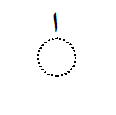Alif
 Alif |
|||||||||||||
|---|---|---|---|---|---|---|---|---|---|---|---|---|---|
| pronunciation | |||||||||||||
| Standard pronunciation | [ ʔ ] | ||||||||||||
| Equivalents | |||||||||||||
| Hebrew |
א
|
||||||||||||
| Phoenician | ? | ||||||||||||
| Aramaic | ? | ||||||||||||
| Syrian | ܐ | ||||||||||||
| transcription | |||||||||||||
| transcription | ' | ||||||||||||
|
|||||||||||||
The Alif ,ألف alif , is the first letter of the Arabic alphabet . Together with the Hebrew Aleph, the Greek Alpha and the Latin A, it is derived from the Phoenician Aleph . The numerical value 1 is assigned to it.
| Alif in isolated form | |
|---|---|
| connected shape | |
| from the right: | ـا |
Sound value and transcription
Alif is used either to lengthen the vowel / a / or as a carrier letter for the Hamza voice paragraph ءand can stand at the beginning of the word for the short vowels / a, i, u /. In some cases it remains silent (e.g. in the 3rd person plural masculine of the perfect perfect (كتبوا - katabū - they wrote)).
Alif for vowel elongation
Alif can serve to elongate a fatha . It then practically fulfills the function of a long vowel, namely the open "A" sound (as in "Abend"). In this case it is reproduced in the DMG inscription as "a" with a line above it (ā).
Alif as a carrier letter
| Alif with Hamza | |
|---|---|
|
|
|
| about that | underneath |
Alif is often the carrier letter for the Hamza voice paragraph, especially at the beginning of a word ء. This hamza expresses the vocal paragraph and in most cases requires a carrier; while this also includes waw in the inside or end of the word وor a ya ي can be, the beginning of the word is always Alif the Hamza bearer.
The Hamza is placed on or below the Alif, depending on the following vowel. It standsأ for / a, u / and إ for / i /.
At the beginning of the word, however, the hamza is usually left out, especially with the specific article al- ال. Then you just write the Alifا(Exceptions are the Hamzat qatʿ and Madda ).
Alif as the carrier letter remains unmarked in the transcription because it does not have its own sound quality.
Mute Alif
In certain verb forms, Alif has a morphological rather than a phonological function at the end of the word; in nouns it serves as the carrier of the indefinite accusative ending ( -an ) at the end of the word ; It is also mute in individual words such asمائة( mi'a , "hundred").
Lām-Alif ligature
If the alif is preceded by a lām , instead of the spellingلـا the ligature لا( Lām-Alif ) used.
Little Alif
There are a handful of words in Arabic today that contain a long a ( ā ) that is not spelled. If the ā is to be reproduced, a small alif can be placed on the preceding consonant (shown as a circle).
Subscript Alif
The Tatar alphabet Yaña imlâ ("New Alphabet"), a variant of the Arabic alphabet used in 1920–1927 to spell Tatar , contains a subscript of the Alif. The Tatar language uses a "front" series of vowels (current Latin / Cyrillic notation: e / э, ıy (i) / ый, ö / ө, ü / ү, ä / ə) and a "rear" (ı / ы, i / и, o / о, u / у, a / a). According to the rules of vowel harmony , Tatar words only contain vowels in a row. The Yaña imlâ now uses the same character for the “front” and “back” variants of a vowel (with the exception of the a / ä pair, since these vowels occur in foreign words from Arabic that are not subject to the vowel harmony rule). The subscript Alif is now placed in front of words that contain vowels of the “back” row, while its absence indicates that the vowels of the word belong to the “front” row.
Similarly, the subscript Alif was used in the Bashkir spelling in 1923–1930 .
The subscript Alif has no connection with the first letter of the word, so its glyph always corresponds to that of the isolated form of the Alif.
When sorting, the subscript Alif is used as an auxiliary character, so it has no position in the alphabet . It is only taken into account if two words are otherwise spelled exactly the same, in this case the word beginning with the subscript Alif directly follows the one without.
Alif in Unicode
| Unicode | U + 0627 |
|---|---|
| Unicode name | arabic letter alef |
| HTML | & # 1575; |
| ISO 8859-6 | 0xc7 |
The superscript Alif is also codified, but is not shown in some fonts.
| Unicode | U + 0670 |
|---|---|
| Unicode name | arabic letter superscript alef |
| HTML | & # 1648; |
| ISO 8859-6 | unavailable |
The subscript Alif has been included in the Unicode standard since version 7.0.
| Unicode | U + 08AD |
|---|---|
| Unicode name | arabic letter low alef |
| HTML | & # 2221; |
| ISO 8859-6 | unavailable |
See also
- Elif , a Turkish female given name derived from Alif
Individual evidence
- ↑ a b Ilya Yevlampiev et al .: Revised Proposal to encode Arabic characters used for Bashkir, Belarusian, Crimean Tatar, and Tatar languages. (PDF) ISO / IEC JTC1 / SC2 / WG2, Document N4071, May 20, 2011, accessed on September 1, 2013 (English).


